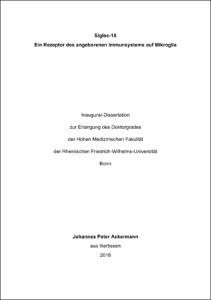Siglec-16Ein Rezeptor des angeborenen Immunsystems auf Mikroglia

Siglec-16
Ein Rezeptor des angeborenen Immunsystems auf Mikroglia

| dc.contributor.advisor | Neumann, Harald | |
| dc.contributor.author | Ackermann, Johannes Peter | |
| dc.date.accessioned | 2020-04-21T16:57:01Z | |
| dc.date.available | 2020-04-21T16:57:01Z | |
| dc.date.issued | 27.06.2016 | |
| dc.identifier.uri | https://hdl.handle.net/20.500.11811/6670 | |
| dc.description.abstract | Mikroglia sind die ortsständigen Immunzellen des zentralen Nervensystems und somit wesentlich an der Überwachung und Erhaltung der Homöostase im empfindlichen neuralen Gewebe beteiligt. Sie treten als Teil des angeborenen Immunsystems über ihre Oberflächenrezeptoren mit ihrer Umgebung in Kontakt. Ein potentieller Rezeptor auf Mikroglia ist der erst kürzlich entdeckte humanspezifische Siglec-16-Rezeptor, der aufgrund einer Mutation nur in einer Subpopulation der Bevölkerung gebildet wird. Ziel dieser Arbeit war die Untersuchung von Vorkommen, Funktion und Wirkung von Siglec-16 auf Mikroglia. Dazu dienten humane Gewebeanalysen, Zellkulturmodelle von humaner und muriner Mikroglia und die Erzeugung eines Siglec-16 transgenen Mausmodells. In der vorliegenden Arbeit konnte erstmals der Nachweis einer Expression von Siglec-16 in adultem Hirngewebe sowie auf humanen aus induzierten pluripotenten Stammzellen generierten Mikroglia erbracht werden. Um eine bessere Aussage über den Genotyp und die Allelfrequenz von Siglec-16 treffen zu können, wurde ein auf PCR und Sequenzierung basierende Methode entwickelt, welche eine valide Genotypisierung ermöglicht. Die Etablierung einer Expression von Siglec-16 auf murinen aus embryonalen Stammzellen generierten Mikroglia war ebenso erfolgreich, wie die Erzeugung eines Siglec-16 transgenen Mausmodells mit einer selektiven Expression von Siglec-16 auf Mikroglia. Im murinen System konnte sowohl in Zellkultur als auch im Tiermodell ein hemmender Einfluss von Siglec-16 auf die Genexpression der Entzündungsmediatoren TNF-α und IL-1β gezeigt werden. In Funktionsanalysen von humanen Mikroglia in Zellkultur konnte eine durch LPS induzierte Steigerung der Siglec-16-Expression gezeigt werden. Interessanterweise zeigte sich ein abschwächender Effekt von Siglec-16 auf die durch LPS vermittelte Entzündungsreaktion im Siglec-16 transgenen Mausmodell. Im Weiteren zeigte sich ein positiver Einfluss von Siglec-16 auf die Phagozytoserate von Mikroglia. Weitere Untersuchungen könnten die Bedingungen analysieren, unter welchen Siglec-16 trotz seiner Assoziation mit dem ITAM tragenden DAP12 eine inhibierende Wirkung auf die Immunreaktion hat und welche Stimuli nötig sind sein aktivierendes Potential hervorzurufen. Darüber hinaus könnten weitere Analysen eine mögliche Beteiligung von Siglec-16 an pathologischen Zuständen des ZNS klären. | en |
| dc.description.abstract | Siglec-16 - A receptor of the innate immune system on microglia Microglia are the resident macrophages of the central nervous system. As a part of the innate immune system they survey the surrounding tissue with a variety of receptors on their cell surface. One potential receptor on microglia is Siglec-16. Siglec-16 is a DAP12-associated human specific receptor that binds to sialic acids on the glycocalyx of the cell surface. As a result of a deletion of 4 base pairs only a subpopulation of the human population is able to express the functional gene of Siglec-16. The aim of this thesis was to investigate the presence and the function of the Siglec-16 receptor on microglia. This included genomic studies, cell culture models and the establishment of a transgenic mouse model. In this thesis the detection of an expression of Siglec-16 in human brain tissue and on human-induced stem cell-derived microglia was successful. The development of a method for a PCR and sequencing based testing of the genotype of Siglec-16 led to new insights of the allele frequency of Siglec-16 in human population. It could be shown in cell culture models with human-induced stem cell-derived microglia that the expression of Siglec-16 depends on the influence of LPS. The establishment of a robust expression of Siglec-16 on murine embryonic-derived microglia and in a transgenic mouse model could be performed successfully. With these models it was possible to investigate the influence of Siglec-16 on the expression of inflammatory cytokines and the phagocytosis. We could show that the expression of Siglec-16 led to a down regulation of pro inflammatory molecules, such as TNF-α und IL-1β, and an up regulation of the phagocytosis rate. This influence seems to be modulated by the presence of LPS. Further studies should investigate how the DAP12-associated Siglec-16 is able to affect its anti inflammatory influence on the immune reaction of microglia. Moreover, the examination of the influence of Siglec-16 on neurological disorders, such as multiple sclerosis, stroke or infection, could be of interest for the understanding of the pathogenesis and the development of new therapy concepts. | en |
| dc.language.iso | deu | |
| dc.rights | In Copyright | |
| dc.rights.uri | http://rightsstatements.org/vocab/InC/1.0/ | |
| dc.subject | Sialinsäure | |
| dc.subject | Sialic acid Ig-like lectin | |
| dc.subject | Siglec-16 | |
| dc.subject | Siglec-11 | |
| dc.subject | Siglec | |
| dc.subject | Mikroglia | |
| dc.subject | Transgenes Mausmodell | |
| dc.subject | DAP12 | |
| dc.subject | ITAM | |
| dc.subject | ITIM | |
| dc.subject | Silica acid | |
| dc.subject | microglia | |
| dc.subject | Transgenic mouse model | |
| dc.subject.ddc | 610 Medizin, Gesundheit | |
| dc.title | Siglec-16 | |
| dc.title.alternative | Ein Rezeptor des angeborenen Immunsystems auf Mikroglia | |
| dc.type | Dissertation oder Habilitation | |
| dc.publisher.name | Universitäts- und Landesbibliothek Bonn | |
| dc.publisher.location | Bonn | |
| dc.rights.accessRights | openAccess | |
| dc.identifier.urn | https://nbn-resolving.org/urn:nbn:de:hbz:5n-43752 | |
| ulbbn.pubtype | Erstveröffentlichung | |
| ulbbnediss.affiliation.name | Rheinische Friedrich-Wilhelms-Universität Bonn | |
| ulbbnediss.affiliation.location | Bonn | |
| ulbbnediss.thesis.level | Dissertation | |
| ulbbnediss.dissID | 4375 | |
| ulbbnediss.date.accepted | 15.03.2016 | |
| ulbbnediss.institute | Medizinische Fakultät / Institute : Institut für Rekonstruktive Neurobiologie (IRN) | |
| ulbbnediss.fakultaet | Medizinische Fakultät | |
| dc.contributor.coReferee | Kunz, Wolfram S. |
Files in this item
This item appears in the following Collection(s)
-
E-Dissertationen (2079)




